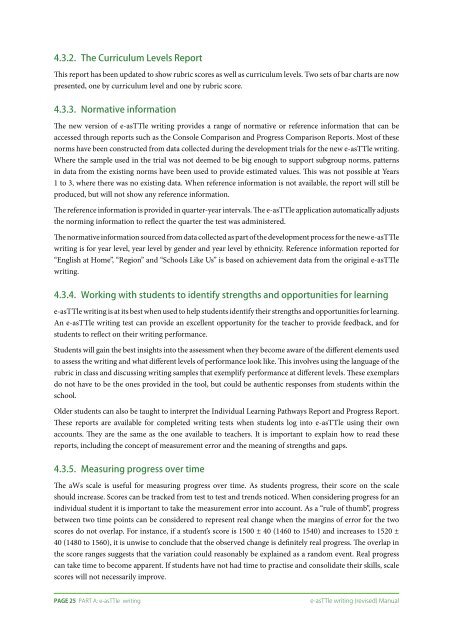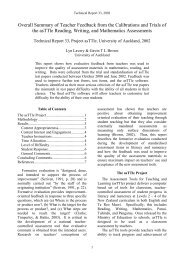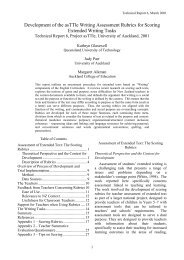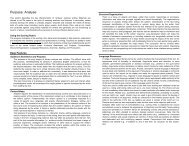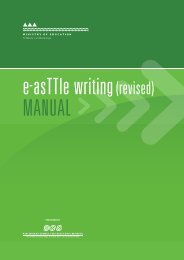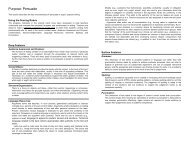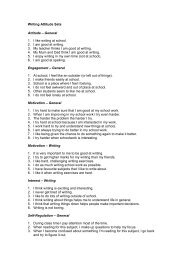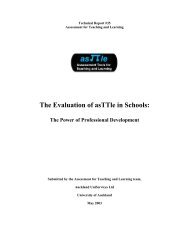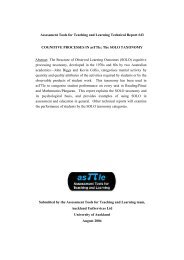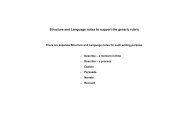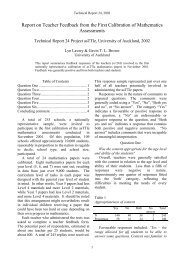e-asTTle writing (revised) Manual 2012.pdf
e-asTTle writing (revised) Manual 2012.pdf
e-asTTle writing (revised) Manual 2012.pdf
Create successful ePaper yourself
Turn your PDF publications into a flip-book with our unique Google optimized e-Paper software.
4.3.2.The Curriculum Levels ReportThis report has been updated to show rubric scores as well as curriculum levels. Two sets of bar charts are nowpresented, one by curriculum level and one by rubric score.4.3.3.Normative informationThe new version of e-<strong>asTTle</strong> <strong>writing</strong> provides a range of normative or reference information that can beaccessed through reports such as the Console Comparison and Progress Comparison Reports. Most of thesenorms have been constructed from data collected during the development trials for the new e-<strong>asTTle</strong> <strong>writing</strong>.Where the sample used in the trial was not deemed to be big enough to support subgroup norms, patternsin data from the existing norms have been used to provide estimated values. This was not possible at Years1 to 3, where there was no existing data. When reference information is not available, the report will still beproduced, but will not show any reference information.The reference information is provided in quarter-year intervals. The e-<strong>asTTle</strong> application automatically adjuststhe norming information to reflect the quarter the test was administered.The normative information sourced from data collected as part of the development process for the new e-<strong>asTTle</strong><strong>writing</strong> is for year level, year level by gender and year level by ethnicity. Reference information reported for“English at Home”, “Region” and “Schools Like Us” is based on achievement data from the original e-<strong>asTTle</strong><strong>writing</strong>.4.3.4.Working with students to identify strengths and opportunities for learninge-<strong>asTTle</strong> <strong>writing</strong> is at its best when used to help students identify their strengths and opportunities for learning.An e-<strong>asTTle</strong> <strong>writing</strong> test can provide an excellent opportunity for the teacher to provide feedback, and forstudents to reflect on their <strong>writing</strong> performance.Students will gain the best insights into the assessment when they become aware of the different elements usedto assess the <strong>writing</strong> and what different levels of performance look like. This involves using the language of therubric in class and discussing <strong>writing</strong> samples that exemplify performance at different levels. These exemplarsdo not have to be the ones provided in the tool, but could be authentic responses from students within theschool.Older students can also be taught to interpret the Individual Learning Pathways Report and Progress Report.These reports are available for completed <strong>writing</strong> tests when students log into e-<strong>asTTle</strong> using their ownaccounts. They are the same as the one available to teachers. It is important to explain how to read thesereports, including the concept of measurement error and the meaning of strengths and gaps.4.3.5.Measuring progress over timeThe aWs scale is useful for measuring progress over time. As students progress, their score on the scaleshould increase. Scores can be tracked from test to test and trends noticed. When considering progress for anindividual student it is important to take the measurement error into account. As a “rule of thumb”, progressbetween two time points can be considered to represent real change when the margins of error for the twoscores do not overlap. For instance, if a student’s score is 1500 ± 40 (1460 to 1540) and increases to 1520 ±40 (1480 to 1560), it is unwise to conclude that the observed change is definitely real progress. The overlap inthe score ranges suggests that the variation could reasonably be explained as a random event. Real progresscan take time to become apparent. If students have not had time to practise and consolidate their skills, scalescores will not necessarily improve.Page 25 Part A: e-<strong>asTTle</strong> <strong>writing</strong>e-<strong>asTTle</strong> <strong>writing</strong> (<strong>revised</strong>) <strong>Manual</strong>


